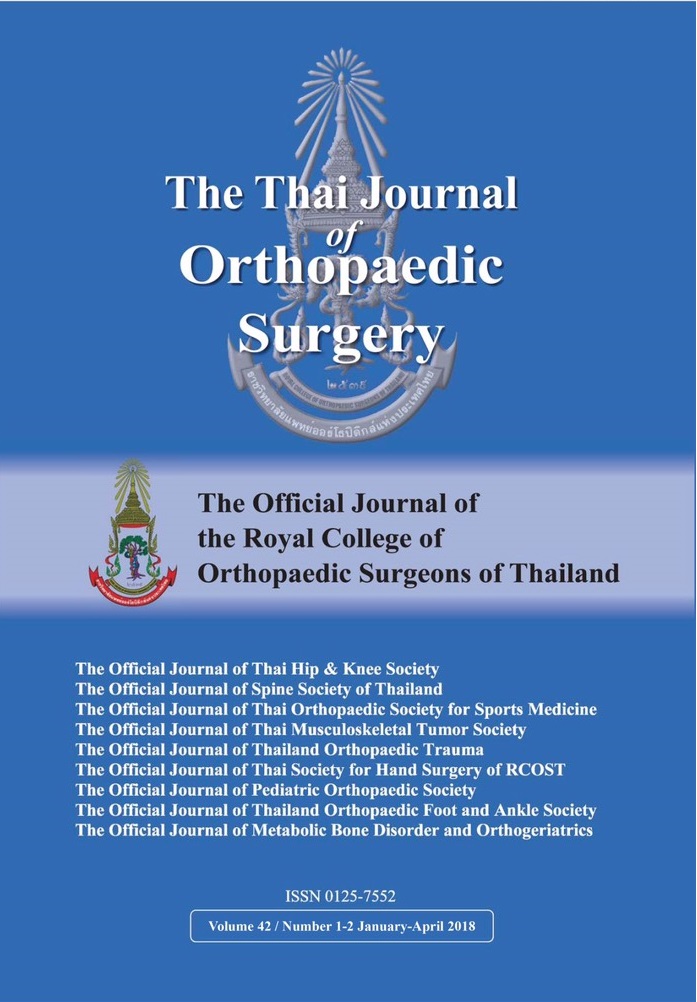The incidence of Anxiety and Depression in Patients with Spinal Injury at Siriraj Spinal Unit
Main Article Content
Abstract
Objective: To investigate the incidence of anxiety and depression among patients with spinal injury admitted to the Siriraj Spinal Unit, and to compare depression and anxiety scores between admission and discharge. We also evaluated for factors that significantly associate with unimproved anxiety and depression score.
Methods: This prospective study included patients with spinal injury that were admitted to the Siriraj Spinal Unit of Siriraj Hospital during December 2013 to August 2017. Presence and level of anxiety and depression were assessed using Thai Hospital Anxiety and Depression Scale (Thai HADS). The following data were collected: age, gender, education level, marital status, occupation, diagnosis, level of impairment, injury severity, cause of injury, and length of stay.
Results: Ninety patients were included, with a mean age of 44.4±16.7 years. There were 68.9% males and 31.1% females. The incidence of anxiety and depression on the day of admission was 8.9% and 7.8%, respectively, with decreases to 4.4% and 5.6% before discharge (Table 2). Mean HADS score for anxiety decreased from 6.1±3.2 to 3.2±2.9, and for depression from 5.1±3.4 to 3.0±3.1. In multivariate analysis, age and marital status were significantly associated with unimproved depression score (P=0.003 and P=0.025, respectively). No evaluated factors were significantly associated with unimproved anxiety score.
Conclusion: The incidence of anxiety and depression decreased from 8.6% and 7.8% to 4.4% and 5.6%, respectively, compared between admission and discharge. Age and marital status were significantly associated with unimproved depression score, while no factors were able to significantly predict unimproved anxiety score.
Article Details
References
2. Homsin P. Factors related to disabled worker’s adaptation at industrial rehabilitation centre, Pathumtani province. Master's thesis (public health nursing), Faculty of Graduate Studies, Mahidol University; 1994.
3. Wattanapan P, Nipitwattanapon C, Vichiansiri R. Prevalence of depression in patients with Spinal cord lesion at Srinagarind Hospital. J Thai Rehabil Med 2010; 20: 46-51.
4. Scivoletto G, Petrelli A, Di Lucente L, Castellano V. Psychological investigation of spinal cord injury patients. Spinal Cord 1997; 35: 516-20.
5. de Carvalho SA, Andrade MJ, Tavares MA, de Freitas JL. Spinal cord injury and psychological response. Gen Hosp Psychiatry 1998; 20: 353-9.
6. Cebrospinal Fluid Research. Available at: http://www.biomedcentral.com/content/pdf/1743-8454-6-S1-S54.pdf . Accessed February 3, 2009.
7. Mehaidat M, Naheyah A, Al-Ghuweri A. Anxiety and depression symptoms among paraplegic patients. Neurosciences (Riyadh) 2005; 10: 112-3.
8. Kuptniratsaikul V, Smerasuta O, Klomjaiyen P. Psychological conditions of spinal cord injury patients. Siriraj Hosp Gaz 2000; 52: 23-9.
9. Nilchaikovit T, Lortrakul M, Phisanuthideth U. Development of Thai version of Hospital Anxiety and Depression Scale in cancer patients. J Psychiatr Assoc Thailand 1996; 41: 18-30.
10. Kennedy P, Lude P, ElfstrÖm ML, Smithson E. Cognitive appraisals, coping and quality of life outcomes: a multi-centre study of spinal cord injury rehabilitation. Spinal Cord 2010; 48: 762-9.
11. Kennedy P, Evans M, Sandhu N. Psychological adjustment to spinal cord injury: the contribution of coping, hope and cognitive appraisals. Psychol Health Med 2009; 14: 17-33.
12. Tresirichod T. Chapter 4 Western and Eastern culture [Internet]. 2017 [cited 2017 Nov 2]. Available from: https://www.slideshare.net/Tee Tre/4-77330178.
13. O’Shea A, Smedema SM. Understanding depressive symptoms among individuals with spinal cord injuries: a biopsychosocial perspective. Rehabil Couns Bull 2014; 58: 20-8.
14. Orenczuk S, Slivinski J, Mehta S, Teasell RW (2010). Depression following spinal cord injury. In Eng JJ, Teasell RW, Miller WC, Wolfe DL, Townson AF, Hsieh JTC, Connolly SJ, Mehta S, Sakakibara BM, editors. Spinal cord injury Rehabilitation Evidence. Version 3.0.
15. Bombardier CH, Richards JS, Krause JS, Tulsky D, Tate DG. Symptoms of major depression in people with spinal cord injury: implications for screening. Arch Phys Med Rehabil 2004; 85: 1749-56.
16. Bombardier CH, Fann JR, Tate DG, Richards JS, Wilson CS, Warren AM, et al. An exploration of modifiable risk factors for depression after spinal cord injury: which factors should we target?. Arch Phys Med Rehabil 2012; 93: 775-81.
17. Post MW, Van Dijk AJ, Van Asbeck FW, Sshrijvers AJ. Life satisfaction of persons with spinal cord injury compared to a population groups. Scand J Rehabil Med 1998; 30: 23-30.
18. Tate DG, Kalpakjian CZ, Forchheimer MB. Quality of life issues in individuals with spinal cord injury. Arch Phys Med Rehabil 2002; 83(12 Suppl 2): S18-25.


